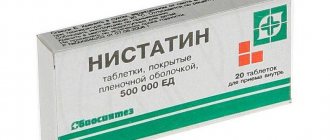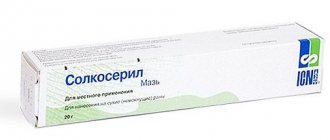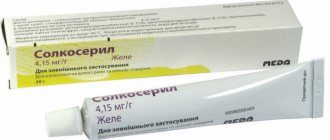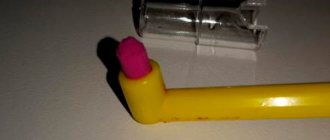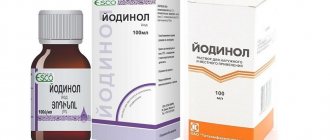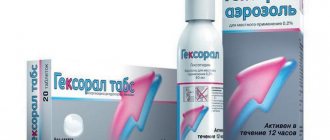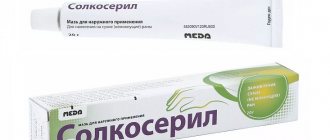Stomatitis is an infectious disease characterized by a rash of multiple ulcers in the oral cavity. The ulcers cause pain while eating and talking. Stomatitis affects people with weakened immune defenses of any age group. Stomatitis is one of the first diseases to appear in newborn infants. Does oxolinic ointment help with stomatitis? Let's consider the methods and features of application.
What is Oxolinic ointment?
This is a pasty viscous substance based on oxoline. The ointment has a yellow tint, a homogeneous, slightly oily structure. Plastic, easily distributed over surfaces. After long-term storage, the product sometimes becomes pinkish or bluish. This feature does not affect its properties.
The medicine is released in different concentrations:
- with oxoline content 0.25%: in tubes of 10 g, used for the treatment of mucous membranes;
- with an active ingredient content of 3%: packaged in tubes of 10–30 g, suitable for treating skin or eliminating intense pathological processes.
Auxiliary compounds of the drug: wax, paraffin, vaseline oil.
Stomatitis
Stomatitis is an insidious disease of viral origin, which in the early stages “disguises” itself as a common sore throat or cold. After a few days, small ulcers and swelling form in the patient’s mouth. They are the main cause of constant discomfort, irritation and pain.
Unpleasant symptoms intensify, causing a lot of inconvenience to the person. It is most difficult for children under 5 years of age. Therefore, it is important to first get rid of painful symptoms, and then from the disease itself. How to do this fastest and most efficiently, read below.
Doctors distinguish 3 types of stomatitis:
- Thrush (candida type). A common manifestation in infants under one year of age.
- Aphthous type inflammation. The main reason that provokes the disease is poor oral hygiene, which is typical for 80% of patients.
- Herpes form. In this case, the disease is caused by high activity of viral infection and weakened immunity.
For the treatment and prevention of each of these inflammations, certain medications have been developed.
Causes of the disease
A whole string of unrelated factors can provoke an exacerbation or manifestation of stomatitis. But most often the causes of the disease are:
- unbalanced diet, high sensitivity to certain foods;
- mechanical damage to the skin;
- hygiene products with a high concentration of SLS (foaming composition that dehydrates the mucous membrane);
- stress.
Each of these factors (to varying degrees) carries the risk of infection with stomatitis.
How does Oxolinic ointment work?
The drug disrupts the integrity of the cell membranes of pathogens, causing their death. When applied to the surface of the skin and mucous membranes, the ointment mechanically prevents their infection, softens, and reduces the symptoms of inflammation. Oxolin affects pathogens of influenza, molluscum contagiosum, herpes simplex, adenoviruses, and rhinoviruses.
The use of ointment does not lead to a systemic effect on the body. The amount of oxoline that penetrates through the capillaries into the blood is insignificant. The product does not accumulate in tissues and has no cumulative effect. Particles that get inside are completely metabolized.
How to replace the drug
What ointments/gels are used for stomatitis? The pharmaceutical industry offers the following drugs:
- acyclovir;
- nystatin;
- methyluracil;
- Cholisal;
- solcoseryl;
- Metrogil denta.
Acyclovir suppresses the activity of the herpes virus and has a similar effect to oxolinic ointment. Nystatin is used for the fungal form of the disease - candidiasis. Methyluracil (and Solcoseryl) is used for the bacterial form of the disease (aphthous type).
Cholisal is a universal gel for all forms of illness. This drug can also be used in infants up to one year old. The disadvantage of the drug is its high price. Metrogyl Denta contains an antibiotic, so self-prescription of the drug is unacceptable. This product is approved for use by children over six years of age.
When to use Oxolinic ointment
Traditionally, the medicine is used during respiratory epidemics and when communicating with possible carriers of influenza viruses. The list of indications for use of the drug includes:
- influenza and other respiratory viral pathologies;
- blepharitis;
- inflammation of the conjunctiva;
- lichen lesions;
- molluscum contagiosum;
- dermatitis;
- herpes stomatitis;
- skin warts of viral origin.
The use of medicine for preventive purposes and at an early stage of pathologies is more effective than for advanced infections. To achieve a pronounced therapeutic effect, this drug must be combined with other drugs.
Description of the drug
Pharmacologists have a large number of drugs in their arsenal to combat stomatitis, each of which has its own active formula. However, it should be kept in mind: the cause of ulceration of the mucous membrane can be of a different nature. There are stomatitis of viral origin, a disease after trauma to the oral cavity, and stomatitis due to a deficiency of vitamins/minerals in the body.
Oxolin belongs to a group of drugs with an active antiviral formula. The ointment prevents the spread of pathogenic microbes/viruses, depriving them of activity and nutrient medium. The fatal effect of the ointment is also aimed at the pathogens of the herpes virus, which causes multiple ulcers on the mucous membranes.
Advantages of oxolinic ointment:
- has a local effect on the site of inflammation;
- has a rapid effect on the mucous membrane;
- has a minimum of contraindications;
- used by adults and children;
- not absorbed into the blood;
- easy to use;
- It's inexpensive.
An active effect of oxolin components on the herpes zoster virus, which belongs to the herpes group, was also noted. It is characteristic that the use of oxolinic ointment as an antiviral agent is justified only on the territory of our state; in Europe, the ointment is not included in the group of antiviral drugs. This is due to the fact that the medicinal formula was discovered by Soviet scientists and did not receive the appropriate certificate of international significance.
Effect of the ointment
Oxolinic ointment for stomatitis is used as prescribed by a doctor. Independent use is unacceptable. To disinfect the oral mucosa for herpetic stomatitis, use 0.25% ointment. A sign of this type of disease is redness of the mucous membrane with multiple rashes of ulcers. The disease is accompanied by hyperthermia and uncontrolled salivation.
Oxolinic ointment for stomatitis in adults and children eliminates not only the symptomatic manifestations of the infection, but also eliminates the cause of the disease. When the drug dries, it forms a protective film that prevents the activity of microbes. Under the film, tissue healing and regeneration occurs.
The product is used for its intended purpose:
- treatment of stomatitis;
- treatment and prevention of ARVI
- viral eye infection.
For preventive purposes, this drug is applied to the nasal mucosa before leaving the house using a cotton swab, as well as in the evening.
Side effects of the ointment
When first applied, a slight burning sensation, increased runny nose, and irritation of the integument are likely to occur. With prolonged daily use, the nasal mucosa may feel dry. The risk of drying out is especially high during simultaneous treatment with vasoconstrictor drops. With proper use of the product, the discomfort gradually goes away on its own. If symptoms increase over time, the ointment should be discarded, as an allergic reaction is possible.
Oxolinic ointment does not affect the speed of psychomotor reactions and the activity of the central nervous system; it is allowed when driving vehicles and operating complex equipment.
Types of stomatitis
The disease is characterized by ulceration of the oral mucosa; however, stomatitis is caused by different viruses. There are several types of disease:
- herpes;
- candida;
- aphthous;
- allergic.
The most common type of stomatitis is considered to be aphthous: it occurs due to poor-quality sanitation of the oral cavity or injury to the mucous membrane. Candidal stomatitis most often affects the mucous membranes of children, while herpes stomatitis is of viral origin.
If the disease is fungal in nature, antifungal drugs should be used; for aphthous stomatitis, antibacterial agents are used; for viral stomatitis, oxolin is used. If the nature of stomatitis is allergic in nature, ointments/gels with antifungal/antiviral agents will not help!
It is important to understand: each type of stomatitis is treated according to a specific scheme. Therefore, independent use of medications is unacceptable. Oxolinic ointment helps only with the viral nature of ailments, in particular, ulceration of the oral mucosa.
The cause of stomatitis can be an incorrect bite, bad habits in a child, or a lack of minerals in the body. Therefore, it makes no sense to use oxolin in this case. Before starting treatment, consult your dentist.
How to determine viral stomatitis in a child
It should be noted that viral stomatitis belongs to the group of contagious diseases and is easily transmitted to a healthy child from a patient. A favorable factor for the development of the virus is the imperfection of the baby’s immune system and poor-quality sanitation of the oral cavity.
In children, viral stomatitis can also appear against the background of eating hot/chilled food: microbes actively penetrate into microcracks in the mucous membrane. Viral activity can be triggered by disruption of the baby’s daily routine, changing seasons, and nervous tension. Any attack on an imperfect immune system can cause a malfunction in the small organism.
Signs of the development of the disease in a child are:
- increased excitability, tearfulness;
- redness and swelling of the oral mucosa;
- refusal to eat, crying when chewing food;
- the appearance of bad breath;
- troubled night's sleep;
- temperature increase.
It is important not to confuse the symptoms of stomatitis with the onset of a flu or cold: the baby behaves exactly the same. However, with a cold, the baby looks tired and lethargic, and the flu is accompanied by a high fever. With stomatitis, the child's behavior is different. Parents should examine the baby's oral cavity to understand the cause of the disease.
Precautions and contraindications in the treatment of oxolinic ointment for stomatitis
There is no information about the dangers of oxolin during pregnancy and during feeding. However, you should consult your doctor about this. He will give recommendations for use. Since no studies have been conducted, it is difficult to say how safe the penetration of oxolin into the mother’s body will be for the fetus.
Individual people may have individual reactions to the components of the ointment (oxolin and additives). If an allergy occurs, you must stop using the ointment and replace it with other products that have a similar effect.
The drug is non-toxic. When applying the ointment to the mucous membranes, no more than a quarter of the volume of the substance is absorbed. At the moment, there is no information about cases involving an overdose of the active substance. Also keep in mind that the ointment dries out the mucous membranes a little; some babies experience irritation and a burning sensation at the sites of application. If such sensations occur, it is recommended to rinse your mouth with chamomile decoction.
Do not self-medicate, and especially treat a child, without the advice of your doctor.
Release form: tube with a plastic cap. Volume - 10 grams. This is enough for several days of regular use.
Look carefully at the release date. The shelf life of oxolinic ointment is two years. Do not use expired medication. In order for oxolin to retain its properties, it is recommended to store it at a temperature no higher than +10 degrees. When heated, the ointment becomes too liquid and does not adhere to the mucous membranes.
As you can see, this cheap and simple ointment from the pharmacy has excellent effectiveness at a cheap price. Since its invention in 1970, it has shown good results in the fight against viral infections.
5 best analogues of oxolinic ointment in the fight against stomatitis:
| Name | Description | Price |
| Kamistad gel | It is produced in the form of a gel and ointment. This product must be applied to the affected area of the mucous membrane in a small layer, rubbing in with light movements. Apply 3 times a day | from 256 rubles |
| Holisal | Used when the oral mucosa is affected by a traumatic or bacterial disease of this type. This effective product is very popular | from 191 rubles |
| Metrogil Denta | It has a pronounced anti-inflammatory and antimicrobial effect. Due to the low concentration of the antibiotic, the product is harmless to the body | from 227 rubles |
| Solcoseryl | Dental adhesive ointment with wound healing, antihypoxic and regenerating effects | from 400 rubles |
| Acyclovir 5% 5g | A product that helps destroy the internal structure of viruses by penetrating their DNA chain | from 22 rubles |
This concludes our story. We hope that the article was useful to you. We are waiting for your comments. By subscribing to the newsletter, you will receive the most interesting and latest news from our website!
Features of the use of oxolinic ointment for stomatitis
The use of oxolinic ointment for stomatitis is effective for the reason that oxolinic is able to destroy and slow down the reproduction of many parasites and viruses, including such a common one as herpes. As you know, the herpetic form of stomatitis is one of the most common in the world, sharing the palm with candidiasis.
Attention! Oxolin is not a universal remedy for all forms of the disease. It is not used for stomatitis caused by candida fungi. Another ointment fights them - nystatin.
- Oxolinic ointment not only reduces ulcers, but also reduces their pain.
- The ointment can be used not only for treatment, but also as an effective and inexpensive prophylactic.
- There is nothing harmful in the composition. In addition to oxoline, it contains petroleum jelly, paraffin, and citric acid.
- Do not confuse 3% and 0.25% ointment. The first is intended for external use.
Acute herpetic stomatitis is a common problem. When transmitted from person to person, the herpes virus is never completely destroyed, integrating into the DNA of the carrier. It is not yet possible to completely destroy it.
Now there are many products on the market that promise to help you get rid of the virus once and for all. This is nothing more than a publicity stunt.
The active ingredient, oxolin, helps strengthen cell membranes. This makes it more difficult for the virus to penetrate the membrane. This leads to localization of the infection. Now the immune system is quite capable of coping on its own.
Video - Does oxolinic ointment help fight viruses?
Oral preparation
Oxolinic ointment for stomatitis in adults is used as follows. Before using the ointment, it is necessary to treat the mucous membrane.
- Using a cotton swab soaked in sea buckthorn, rosehip oil or an oil solution of vitamin A, treat the surface affected by stomatitis. It is necessary to remove dried crusts.
- Next, you need to rinse your mouth. A decoction of calendula, chamomile or nettle is suitable for this purpose. If you have chamomile tincture on hand, that can also be used.
- To eliminate discomfort and pain, you can use various antiseptic solutions.
Some people believe that it is enough to anoint the sores a couple of times and everything will go away. This is a common misconception caused by advertising of various medications. In real medicine there is no such thing as on TV. In order for the active substance to produce the desired effect, the procedure is repeated up to 4 times a day. The duration of treatment ranges from 5 days to a week.
Another important point is how to smear. Most people only apply the ointment to the sores themselves. This is the wrong approach. In this case, the viral infection may spread to other nearby areas. In order for the effect to be maximum, it is necessary to treat the mucous membrane completely. After the ointment is applied, do not eat or drink for an hour. Only in this case is it possible to obtain a therapeutic effect.
